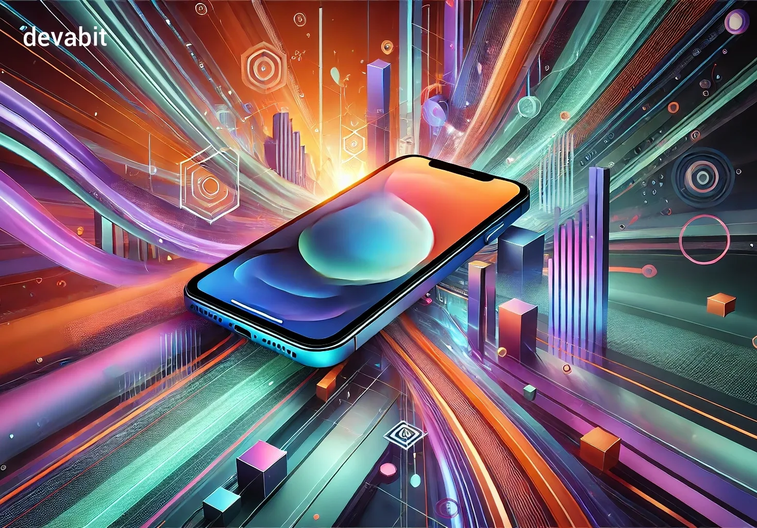Payment App Development: Main Features—Opportunities—Threads
In our fast-changing digital world, the payment app development process has become essential for businesses that want to stay in the game. Customers now expect quick, safe, and smooth transactions on their mobile devices. So payment apps are not just a nice thing to have—they are a must-have! But it is not simple to start making payment apps—it brings many challenges. You need just the right mix of top-notch tech, rock-solid security, and design focused on the user. Here, at devabit, we get how tough this business can be. Our experienced team is here to help and guide you through each step. Whether you are planning your very first app or want to improve the app you already have—we have got info that will help break down everything important—all possibilities waiting for you as well as any threats that might come up along the way.
In short, today we will talk about:
- Payment app development involves creating applications that enable users to easily transfer money between their phones, tablets, or computers.
- More than 80% of users worldwide utilize payment apps for daily shopping.
- There are several key features of a successful payment app development: user authentication, payment gateway integration, multi-currency support, transaction history, data encryption, and push notifications, to name a few.
- By the end of 2027, mobile transactions are expected to reach $12.06 trillion, paving the way for payment app development services.
- Equipping your payment app with loyalty programs, like cashback offers or tailored incentives, encourages customers to interact with it more frequently.
- Transferring money through payment applications can potentially reduce extra charges by up to 30%.
Our handy guide is full of advice based on successful experiences and insights from industry leaders that equip you with all the knowledge needed so your payment app can not only meet but even surpass business goals while standing out among its rivals. With everything from strong safety measures in place to smart new features that make using it a breeze—the expertise we provide at devabit gives power back into your hands, allowing you to transform your application into a useful tool.
Do not miss reading further about how payment app development may unlock untapped business potential, thereby positioning oneself towards victory lane within this highly competitive scenario.

What Is Payment App Development and Why It Is Important
Payment app development is simply about making software that lets users safely move money back and forth through their phones, tablets, or computers. These apps are super important in our modern digital world because they handle so many money transfers it would make your head spin!
Actually, Statista experts predict that by the year 2027, there will be over $12 trillion in mobile payments going on every year. That shows how much people are in need of quick, safe ways to pay for issues. The reason why we need these payment apps comes down to a few big points.
First off, nowadays everybody is super busy, so everyone wants fast and simple ways of doing things, including paying for different issues. Current statistics by PYMNTS tell us that 82% of us use payment apps like these for daily shopping, which clearly demonstrates more people are turning away from cash towards digital dollars.
Next up is safety—protecting your cash from thieves looking to steal it online. Payment app development lets businesses add really good security features, such as passwords only you can know or measures checking if it is actually you trying to spend your money. And this kind of security matters big time—cybercrime costs could go higher than $10.5 trillion each year after 2023, according to Cybersecurity Ventures information.

Another point for payment app development involves businesses that want to grow abroad. With a whopping yearly total of $156 trillion being spent overseas, according to the McKinsey report, firms need smooth methods for handling those international payments. Thanks again to the payment applications' abilities to process different currencies swiftly, complying with various country laws and growing businesses becomes a lot easier, helping them sidestep confusing old-fashioned banking rules.
Last but not least, who does not love saving some dues? Regular banks sometimes charge an arm and a leg per transaction, while digital gates provide cheaper options. The Worldpay Global Payments Report says likely half e-commerce dealings might be mobile payments in 2024, which means businesses by developing payment apps will shave off expenses and better serve their customers, offering them easy services.
In simple terms, payment app development is not merely a tech tip—it is a smart step that pushes progress, improves how customers feel, and assists companies to keep up in an ever-growing online world. If your aim is to boost customer satisfaction, grow worldwide, or make operations smooth as silk, putting resources into payment app development is the clear road to victory.
Main Features of a Successful Payment App Development
Payment app development is not just about transferring money. It is about including crucial aspects that guarantee safety, ease of use, and the ability to grow. A top-notch payment app must offer an amazing user experience while keeping strong security checks in place. Let us tell you more about the vital components that can make or break your app for payments.
User Authentication
One of the most important parts of any payment app development is confirming who is using it. This is how we keep unauthorized users out of our apps. Having reliable verification methods, like multi-factor authentication (MFA), biometric confirmation (like fingerprint or face ID), and OTP (one-time password) systems, strengthens our safeguarding measures against misuse of accounts while also building trust by demonstrating our commitment to maintain app safety standards.
Did you know that apps with biometric verification have 60% fewer fraud attempts based on recent studies? So this feature is definitely one to include if you are looking to develop a trustworthy platform for payments.

Payment Gateway Integration
A top-tier payment app development should blend seamlessly with different gateways used for transactions, so it can operate quickly and efficiently under all conditions. When your application syncs well with various transaction routes, customers can use credit cards, digital wallets, such as Google Pay or Apple Pay, and bank transfers; it secures speedy processing regardless of the method selected by users across numerous platforms available worldwide.
Gateway integration does not only quick processes but also makes navigating these tech pathways simple, enhancing overall user experiences. Also, the provision given by gateways for real-timely handling transactions minimizes time wasted waiting, endlessly cutting short delays and offering easier transaction system flow paths.
Multi-Currency Support
As companies reach wider audiences globally, catering to multiple currencies becomes more necessary than ever. An effective payment app development allows clients to use their preferred currency, thereby easing international transactions. This could be especially useful for service providers and e-commerce platforms that handle customers worldwide.
The ability of the application to instantly switch rates while factoring current global financial shifts helps users understand what equivalent amount they would pay in local currencies before finalizing any monetary exchanges. It is not only about making cross-border payments simpler but also about finding newer revenue sources via extending business outreach capacity across borders.
Transaction History
It is really important for people to see all their past payments in one place. This helps them know about how much they have spent and understand where their money is going. A good payment app development will show all these details in an easy-to-understand way, letting users search through past payments by date, method of payment, or kind of transaction. Offering this feature means your app helps users feel more in control over their spending. It makes using the app a positive experience for clients and means they will keep coming back for more.
Data Encryption
Nowadays, it is vital that any payment app development guards its users’ sensitive information from being stolen online. To do this, we change the information into code that cannot be read while it goes from one part of the internet to another—this is what encryption does.
Techniques like end-to-end encryption (E2EE) and secure socket layer (SSL) help create safe connections between phones and servers when using apps. Lots of people today worry about keeping financial data private—around 85 of every 100 users are worried about it (PwC). So, having high-grade security measures gives peace-of-mind and builds trust with users—because staying safe is not just optional.
Push Notifications
Instant alerts are very important as they always keep you updated on-the-go about everything related to your account activity; these little reminders could pop up when you have completed a payment transfer successfully, or if there is some bill due, or even if something does not go as planned during any transaction process.

The goal here is ensuring you are never left clueless regarding anything happening under your watch concerning finances. Besides, real-time updates also deliver pointers whenever there happen to be needful security modifications alerting us against suspicious logins, thus serving a two-way identification, making sure we stay constantly engaged knowing exactly what needs attention.
Opportunities in Payment App Development
The trend of payment app development is rising rapidly. This opens up a lot of ways for different businesses to dive into this constantly evolving area. Payment app development can be profitable, boost interactions with customers, and give your company an edge in the digital world. Here are some potential benefits linked with payment app development.
Growing Market Demand
People around the globe are more and more interested in using payment app development. Estimates by Allied Market Research show that by 2027, mobile transactions could get as high as $12.06 trillion. That means consumers want fresh, trustworthy solutions to pay bills quickly and securely right from their phone or tablet rather than cash or cards.
The call for such services creates plenty of chances for firms looking to build their own payment apps, catering specifically to e-commerce, traditional shops, or person-to-person transfers (P2P). Companies keen on banking could set themselves ahead in digital creative finance solutions, capturing a bigger part of this fast-growing pie.
Cross-Border Payments
Our economy is getting increasingly global every day, which brings forth the necessity to handle international financial exchanges if you are operating worldwide business-wise. With estimated total value reaching up to $156 trillion involving only cross-border transactions last year, according to McKinsey, it is clear there is a big room for growth.

Payment applications, offering features like multi-currency support, immediate currency conversion rates, and adherence to international rules, can have an edge on their competitors. Companies looking to branch out into new territories will find such applications attractive as they simplify overseas payments. This can help draw in users from around the world, push revenue trends upward, and create connections with firms abroad.
Customer Loyalty
Payment app development gives businesses a special way to earn and keep customer trust. Adding loyalty programs, like cashback offers or tailored incentives, directly into these apps encourages customers to interact with them more frequently. Did you know that, according to Accenture, about 78% of consumers are likely going to use payment apps rewarding regular purchases?
Incorporating fun engagement strategies, like point systems or prizes given out based on usage frequency, can strengthen customer loyalty even further. Additionally, exploring data related to individual consumer preferences could allow companies to offer unique rewards for each user along with personalized deals. It results in deepening bonds with customers, which leads to an enhanced retention rate.
Cost Efficiency
Payment app development might be among the most economical moves the business can make—one major reason that helps save money compared to usual banking costs. Old-school banking methods often come with high transaction fees, which inflate processing costs. However, having your own customized solution allows companies to skip those traditional extra charges, thereby reducing the total operation cost associated with finance transfer.
According to a McKinsey study, transferring amounts through digital solutions possibly cuts down on extra charges up to 30%. This makes platforms for transactions an economical option regardless of the establishment size. In addition, payment app development is not just something positive for businesses. It is a bonus to all customers as you can offer them faster, cheaper, yet convenient means of sending or receiving payments.
Key Challenges and Threats in Payment App Development
Payment app development offers great potential, but the journey to success has its difficulties. Businesses jumping into this field must face many issues, ranging from security points, rules and regulations they have to abide by, and cutthroat competition. Being aware of these crucial hurdles allows businesses to tackle risks head-on and create successful, secure, and rule-abiding payment apps.
Security Risks
Safety is the prime issue in the payment app development. Since confidential financial data is being swapped around and stored, cybercriminals often target payment apps with methods like digital thefts or malware attacks. As per Cybersecurity Ventures' forecast for 2023, cybercrime damages may skyrocket over $10.5 trillion annually! To counter these threats, developers are obliged to include first-class safety measures, such as complete encryption at each step of the process (end-to-end) and authenticating through multiple stages (multi-factor), among others.
Yet, defending against security threats is an ongoing battle since hackers keep changing their styles constantly, requiring businesses to stay on their legs by frequently modifying their safeguarding protocols. However, ignoring defense against illicit activities can lead to trust issues, legal actions, and monetary downturns, occurring with heavy losses.

Regulatory Compliance
In the payment app development industry, there are numerous regulatory compliance demands that create other significant obstructions to consider. Payment applications subserviently follow certain locale-specific laws designed, namely consumer safety protocols, preventing fraudulent attempts, and ensuring transparency. As an example, in Europe, payment apps have to follow two special sets of rules—General Data Protection Regulation (GDPR) and Payment Services Directive 2 (PSD2). Both these demand high security and secrecy about who uses that data.
Now, apart from GDPR and PSD2 rules mentioned earlier, businesses also need to obey some financial sector-specific laws. There is 'Know Your Customer' (KYC), which asks for detailed proof about a person's identity; then there is the Anti-Money Laundering (AML) law that keeps tabs on shady dealings. These add another layer of intricacy in payment app development. If companies slack off or slip up with these regulatory details, they could face heavy fines or even legal action. Aside from this is the possibility of harm being done to your brand’s status.
Competition
The world of payment app development is stuffed with competition, both from established enterprises and new startups on the block trying to grab their piece of pie. Giants like PayPal, Venmo, and Apple Pay have a firm grip on the market scene, which makes it tough for novice apps to make inroads. With an ever-rising volume of payment app development solutions in the market, firms must discover ways to stand apart and offer unique features that add value.
Finding ways to be different in such an overcrowded scene demands fresh ideas and a deep knowledge of what users are after. Whether it is by offering top-notch security features or user-friendly experiences, surprise perks for loyalty—businesses need to find something they can give customers that their competitors just do not offer.

The real task is not just winning over new users but holding onto them, considering they are spoilt for choice when switching around is so easy. To keep pace with the competitors, companies will need to regularly retool themselves based on changes in trend patterns within business environments.
Why Choose devabit for Payment App Development?
When it comes to payment app development, finding the right team can change everything. At devabit, we know that a winning payment app needs more than just tech smarts; it also needs good knowledge of finance and user behavior. Our experienced group of professionals is devoted to creating top-quality solutions ideal for your business needs. Whether you need slick link-ups with payment gateways or setting up rock-solid security measures, we guarantee an app poised for success in today's competitive stage.
What makes devabit stand out is our focus on you—our client. We do not merely make apps—we craft powerful tools designed to help reach your business targets. By tapping into the latest technologies and keeping a step ahead of industry changes, we promise an effective, safe, and satisfying payment app experience for users.
Wanting your business to level up by offering a stellar payment solution? Let our experienced devabit team guide you through this technology adventure. Contact us today so together we can create a unique payment application that gives your company its edge over competitors!
Recent Publications
Don't miss out! Click here to stay in touch.
Discover More

Relevant Articles View all categories
View all categories CONNECT WITH US WE’RE READY
TO TALK OPPORTUNITIES
THANK YOU! WE RECEIVED YOUR MESSAGE.
Sorry
something went wrong



